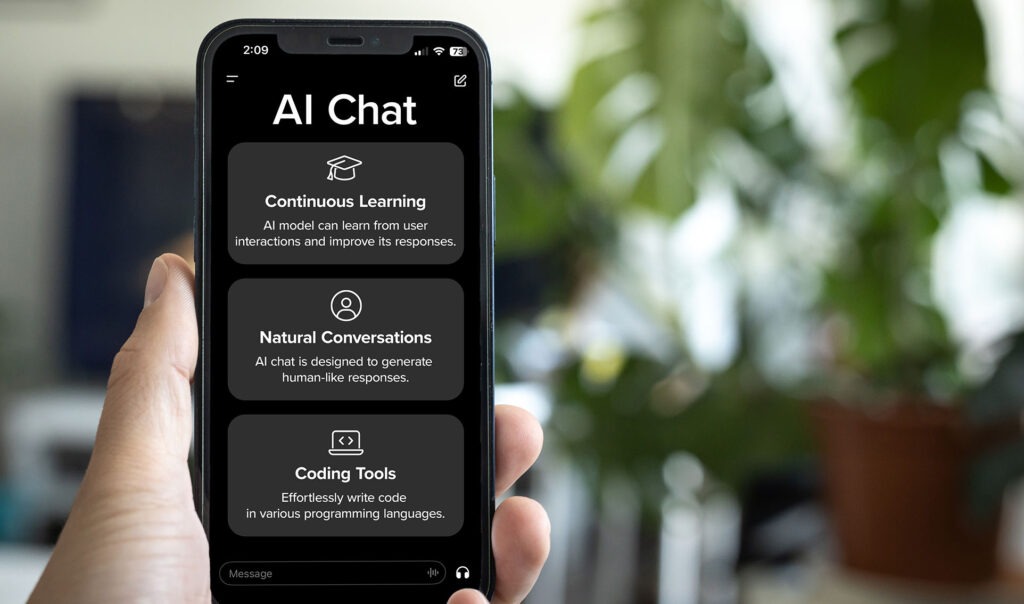Conversational AI in Banking: The Next Industry Transformation
Imagine a reliable virtual assistant that could securely offer guidance and support to your customers and employees without human intervention. With the exponential growth of generative artificial intelligence (AI) and deep learning models like ChatGPT, that future of heightened productivity and self-service in banking may be closer than you’d think.
Today, community banks face mounting challenges in delivering personalized, timely support to consumers who increasingly expect seamless digital banking options. Limited resources in staffing and dollars often lead to internal strain at best, and at worst, poor customer experiences, high attrition and stagnant growth.
Generative AI could change all that, enabling banks to leapfrog their capabilities overnight and provide hyper-personalized, around-the-clock service. AI-utilizing tools have the potential to level the playing field between big banks and community institutions. Deployed well, this exciting new technology could position community banks to retain and expand their customer base rather than cede ground to national players.
So, what exactly is generative AI, where does the financial services industry stand and where will it go? This blog explores potential applications, proposals, concerns and to help bankers sift through the noise and determine their AI strategy.
Defining Key Terms of Deep Learning Models
Industry veterans know banks have used AI for years, particularly for fraud prevention. However, recent AI buzz stems from the eruption of generative AI, sometimes called conversational AI, popularized by models like ChatGPT. These represent two types of artificial intelligence with slightly different goals:
- Discriminative AI uses a dataset of trained data to uncover relationships between data points, classify them and make predictions within that set. Traditional discriminative AI models, often used in machine learning, distinguish between different data classes. They learn the boundaries between other types to predict new data accurately.
- Generative AI generates new data like the data it was trained on and understands the probabilities of examples to make informed predictions. Unlike discriminative models, generative models can create entirely new data not present in the training data. This is particularly useful when data availability is limited or synthetic data is needed, such as when creating virtual environments, designing new molecules for drug discovery or generating artificial voices or images.
In short, discriminative AI primarily differentiates between existing data and classifies it, while generative AI models how data is distributed and generates data of the same type. Both dig through massive amounts of information to help us understand and act on it. As a result, these models, in conjunction with automation, may soon become critical aspects of banks’ technology stacks.
The Potential of Generative AI in Banking
Discriminative AI, while valuable, is often used in more straightforward classification tasks such as spam detection, image recognition or risk prediction and mostly requires structured data (typically quantitative) to operate. In banking, this is most commonly applied in fraud and AML prevention.
By contrast, generative AI can leverage significant volumes of unstructured data – or ‘dark data’ – often estimated to be as much as 80% or more of a typical organization’s data. This includes emails, chats, ticketing systems, user notes, actions and other application data.
While discriminative AI has revolutionized many industries by classifying and predicting, generative AI is poised to start another revolution. Today’s applications that draw from generative AI include text, visualization and video content generation. They can take the form of AI chatbots, content creation tools, deepfake technologies and application development. While these applications are not limited to banking, there are many potential uses that bankers could take advantage of.
At a base level, generative AI can produce content and answers quickly. Taken further, it could improve our decision-making processes, problem-solving and overall cognitive abilities. For its potential to create previously inconceivable innovations, McKinsey estimates generative AI could add trillions of dollars to the global economy and $200 billion to $340 billion annually to the banking sector.

AI Applications for the Back Office
One of the most common goals across banks’ technology strategies is increasing efficiency. Since AI, machine learning and automation like RPA facilitate significant productivity gains, it’s no surprise that bankers would be interested in using generative AI to speed up daily work. Imagine how much easier training, customer service or technical tasks would be with immediate, personalized guidance.
Some bankers and technology professionals already use ChatGPT or similar tools to increase productivity. Looking ahead, generative AI’s reach could extend further:
Virtual Assistants
One likely application is a virtual assistant that could help bankers locate essential information, optimize customer data, offer recommendations and more. In addition to context-aware responses to bankers’ questions, it has the potential to generate help documents or guidance with more specificity, like simulated instructional “
Better Use of Data
Generative AI can also absorb massive amounts of data, making it more digestible and actionable in areas like identifying sales opportunities, personalizing service and collating CRM interactions. Whether it’s onboarding or IT or HR reports, Natural language processing (NLP), a branch of AI that enables computers to generate natural human language, could make the numbers easily comprehensible.
Programming Support
For programmers, it could also help with coding and developer support, API management, credit underwriting and process optimization. This application could enable faster technology deployment and the ability to iterate and improve by generating code under programmers’ parameters.
Troubleshooting
Celent also recently proposed that we could see maturing supporting back-office troubleshooting within the next five years, like diagnosing the root cause of transaction issues and creating visuals of failure points. In other words, if a process has a choke point or a customer journey stalls, AI could conceivably offer contextual insight into how to correct the issue.
AI Applications in Fighting Financial Crimes
AI has the capacity to take anti-money laundering (AML) software to new heights, helping organizations more quickly and easily discover everything money launderers hope to hide. In today’s typical cases, an AI model learns from an organization’s prior AML transaction monitoring, from both inside and outside the organization, to inform decisions about the current day’s alerts.
When fighting financial crimes, AI and machine learning draw from previous investigations and emerging trends to isolate abnormal behavior and pinpoint difficult-to-see connections. From there, this technology allows systems to generate customer risk scores and alerts, automate case closing and prevention and ultimately streamline investigations.
Generative AI could further accelerate these efforts by accessing larger pools of dark data, generating investigative aids, comprehensive reports in plain language, compliance and sanctions guides, code guides and more. It can also be used to dive through extensive reports and rulings to pick out the most critical takeaways.
By analyzing payment data about past fraudulent transactions, generative AI could also learn to identify patterns and develop predictive models to flag suspicious activity in real time. This is increasingly significant in the era of instant payments. In all cases, generative AI can push these efforts further by compiling comprehensive written reports and generating entirely new risk-based models.
AI Applications in Sales and Marketing
Conversational AI can also be used to improve sales and marketing efforts, potentially accelerating content creation, search engine optimization (SEO) recommendations, highly targeted and personalized campaigns informed by CRM data and more. Few have the time to personalize every email beyond the traditional persona model, but with AI implemented well, that possibility is much more reachable.
While it requires human oversight, AI tools like ChatGPT already represent a significant creativity boost. Conversational AI helps hone ideas and scan for grammar and word choice improvements for emails, web pages, blogs and more. With a well-structured prompt, it can quickly generate outlines, blog topics, writing feedback and more. And generated images are also now on the table, opening the door for faster financial guidance.
It’s also conceivable that AI could be trained to generate to update mobile apps, create web pages, write a new platform altogether or optimize an existing site. Other possible applications include an enterprise search of documents, employee-facing chat, next steps and recommendations, sales support to cross-sell, relationship-based pricing and building out tailored marketing communications and graphics.
Traditional SEO might even become outmoded in the coming years, as generative AI plugins will assess and tag easily consumable content and ultimately include more information from multiple sources. While proposed rules may require extensive sourcing in AI-generated results, those marketers who can get ahead of the trends and figure out ways to embrace chat engine optimization will have a leg up in making their content visible.
AI Applications for Banking Customer Service
While many bankers may hesitate to outsource customer service to AI, it has the potential to exponentially enable digital self-service and streamline customer service logistics, like call routing or callback scheduling. Mirroring an assistant for bankers, this could be a customer-facing virtual service representative that supports customers through voice, chat and SMS. Such a platform would be trained on extensive reserves of banking data, documentation and past support interactions.
Generative AI could revolutionize banking customer service by automating first-level support, incorporating natural language processing for understanding queries and utilizing conversation recollection to offer personalized, context-aware responses. Using customer data, this technology could help personalize interactions, identify sales opportunities and elevate self-service.
At a base level, it could provide instant answers to account inquiries, balances, transaction history, money transfers and loan applications. Extended further, generative AI could enable more complex customer service features like credit score monitoring and offer financial advice and planning.
With applications across digital banking, chatbots, call centers and self-service, AI-driven customer service could enhance persona-based banking, intelligent payment routing and payment reconciliation. This efficiency driver could significantly improve customer satisfaction, operations and new customer conversion when paired with trained bankers to monitor as needed or step in when preferred.
The Potential Risks of Generative AI in Banking
Few innovations are without potential pitfalls and caveats, heightening concern for regulated industries like financial services. So, any investment in the technology must go hand in hand with thoughtful planning, extensive collaboration and an understanding of potential risks.
One commonly noted risk is the tendency for AI to generate seemingly true but ultimately inaccurate outputs when drawing from insufficient data. These so-called “hallucinations” may seem plausible, so the general use of generative AI requires monitoring and validation, as well as strategic use of tools or practices that eliminate false patterns, like pulling exclusively from the prompt or data provided.
Additionally, there are regulatory considerations, such as potential intellectual property theft or violations of CFPB rules from inherent bias in the model. Although researchers are exploring methods to curtail these risks, more direction is expected from regulators. In addition to complying with any emergent AI regulations, banks should ensure that their use of generative AI complies with rules governing fair treatment and data privacy.
And finally, generative AI can also be used by bad actors to mislead and exacerbate problems like fraud. The trends of AI-generated scams like deepfakes and personalized phishing emails are only likely to increase, requiring heightened vigilance across industries.

Where the Banking Industry Stands on AI
Recent research suggest that many bankers are interested in adopting new AI capabilities. Large banks are already transitioning from exploration to deployment, with generative AI expected to integrate into existing solutions by 2024. Likewise, major cloud infrastructure providers are aggressively moving to deploy , becoming more embedded in offerings like Microsoft 365.
However, many smaller institutions have adopted a “wait and see attitude,” with far fewer considering chatbots or generative AI as critical components of their strategies. Much of this cautious approach stems from the need for more regulatory clarity and concerns regarding AI-related tools’ overall safety and security. Many also have concerns over the ethics and reliability of such models.
Nevertheless, they improve daily, and many potential problems stemming from insufficient data can be curtailed with training on prompt engineering. In addition, techniques like retrieval-augmented generation (RAG), an AI framework that grounds large language models on the most up-to-date information, are already being developed and deployed to ensure large language outputs are accurate.
More movement in the space will likely follow regulatory clarity. A recent executive order, among other proposed rules, has begun that process. While the order’s most direct link to the banking industry involves instructions to the Consumer Financial Protection Bureau (CFPB), it sets the stage for broader AI governance and regulation. So, open and frequent dialogue between FIs and regulators will be essential moving forward, particularly around safety assessments, equity guidelines and research initiatives.
The Future of AI in Banking
Words like revolution and transformation can be overused. But in this case, the rapid technological development may be the most significant milestone since the arrival of the smartphone or the digitization of banking. AI-powered tools like virtual assistants could transform how we work, serve customers and take in knowledge.
Small institutions with limited resources and essentially create a virtual team of experts that help individual contributors scale. Many banks already require their employees to wear many hats, and these tools will help them do so more effectively.
As investment in this space continues, banks and technology providers must consider robust policies and governance for data and models, including appointing an enterprise-level AI governance leader. Employee and customer education on AI, including disclosures and threat prevention, is also crucial.
Until then, bankers might as well experiment in their own time with tools like ChatGPT and become competent in prompt engineering. If it hasn’t already come in handy, it’s just a matter of time.
Want the banker’s perspective on today’s banking trends? Don’t miss our Banking Priorities Executive Report.

With a strong focus on emerging technologies and how they apply to the financial industry, Matt has led CSI’s effort to drive innovation in the payment space. Matt has worked for more than a decade at CSI to enhance customer experience and helped direct innovative product offerings to increase bank profitability, allowing banks to realize industry-leading results and maximize program performance. He has spoken at dozens of state and national conferences on the future of banking and is bizarrely passionate about innovation and consumer experiences.

